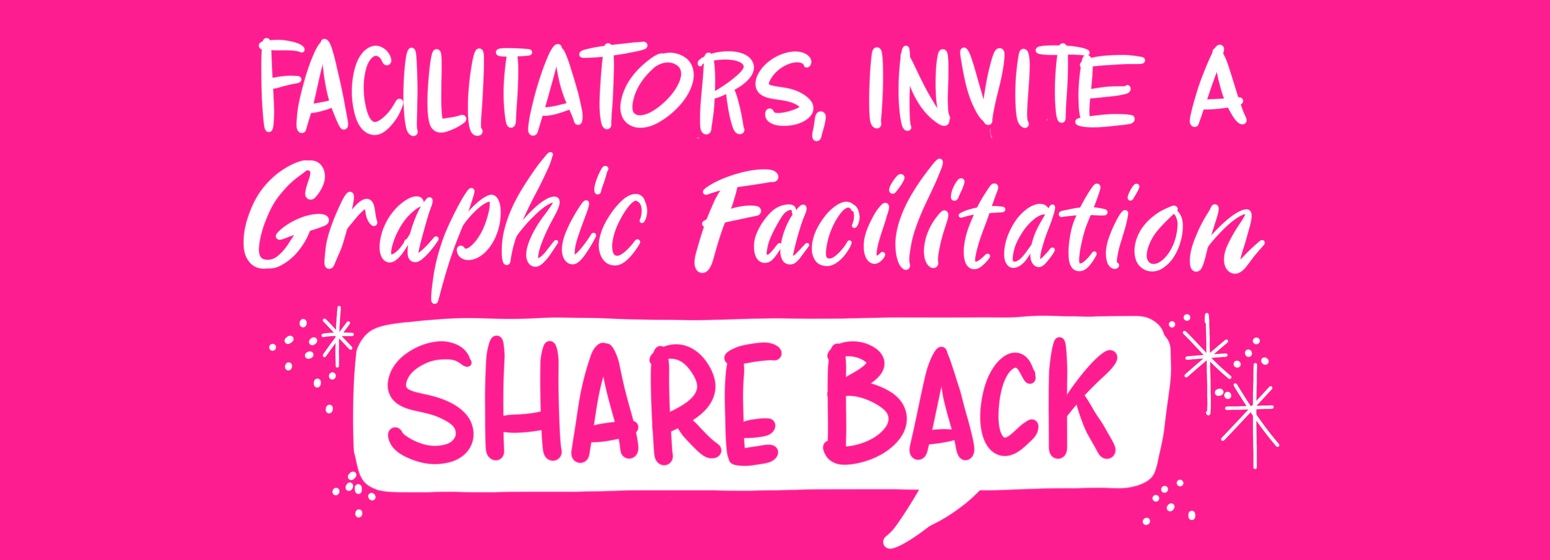
Don’t overlook this step – a graphic recording share back for accessibility
It’s a best practice in our field to share our graphic facilitation work out loud during a session, and give a summary to the room. But these days, I don’t see it happening as much as it could. Early in my graphic facilitation career, I was lucky that my mentors emphasized the importance of presenting our work to the room, even if we don’t feel “finished”, or “ready to talk about it”. Three possible reasons that the share back gets overlooked: 1) faster paced online graphic recording sessions compresses the agenda, 2) practitioners expect the work to speak for itself and so they don’t enjoy this part or know what to say, or 3) people might not know that it’s even something to advocate for on behalf of the graphic recording process. Absolutely, it should happen: during a share back, the graphic facilitator and the visuals can provide the fullest benefit for participants when it matters most, and create moments of meaning-making, deeper connection, and thoughtful engagement. It’s also important for accessibility so the most people possible can engage with what has been created.
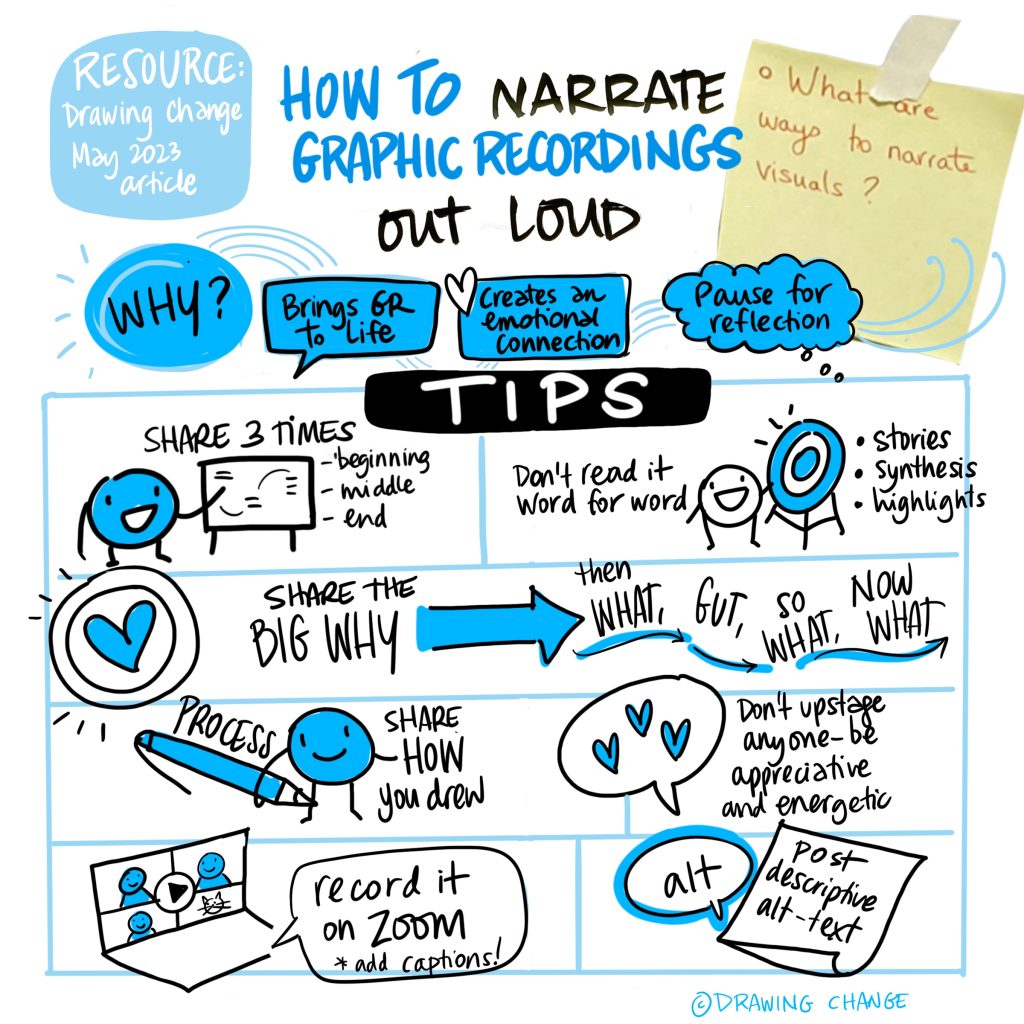
Bring voice to the graphic recording work
Talking about the graphic recording posters out loud brings the two-dimensional posters to life. It brings voice to your role and expertise, and as you present, it invites the participants to create an emotional connection to you and also the work. The share-back starts back in time as we tell the story of the graphic recording journey from the beginning up until the present moment, and this creates a pause for participants to reflect. After a share-back, everyone is on the same page and brought up to speed, so it’s then a powerful time for the facilitation team to ask the room to engage or take next steps in some way.
This also means, for many types of events, that you present the visuals at the end of the session. (This is a whole other topic about fit and purpose for graphic recording, and about perfectionism. But overall, one of the most important roles of graphic recording and facilitation is the ability for the graphics to make the process easier – because to facilitate is to support the room. So for many types of dialogue, planning and strategy work, we don’t maximize the value if graphics are only delivered after everyone has gone home and the event is over – no matter how pretty the graphic might be.)
Common challenges and how to shift them
Here’s some of the common challenges I see with doing a meaningful graphic recording share back, and some suggested ways to shift them.
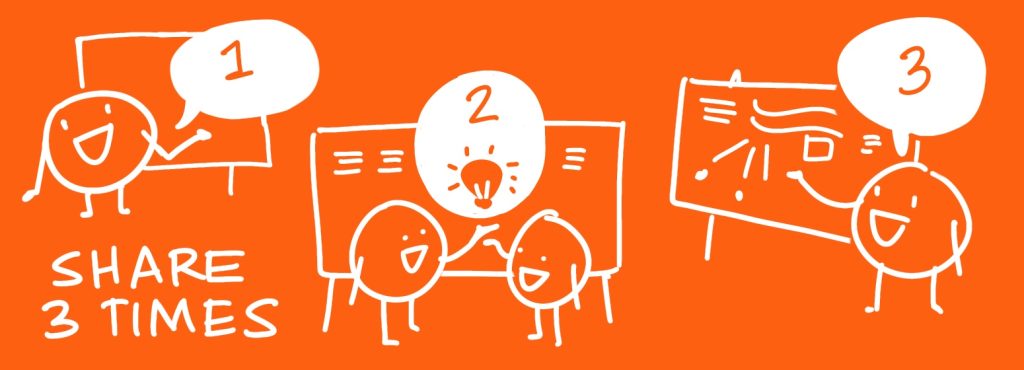
1. Ran out of time to present? Instead, plan ahead so the room hears from you three times.
Don’t leave all your talking until the end of the session. Ask the facilitation team for time on the agenda, and link it to making the event a success for them as well. Plan for a beginning, middle and end when bringing the role of graphic recording into the room. At the beginning, be introduced or introduce yourself. Partway, have an announcement (or activity!) so people feel comfortable coming up to you and also to the posters, even if it’s as simple as them knowing if they can take photos. Then, do a share back at the end of the day (or the beginning of day 2 works).
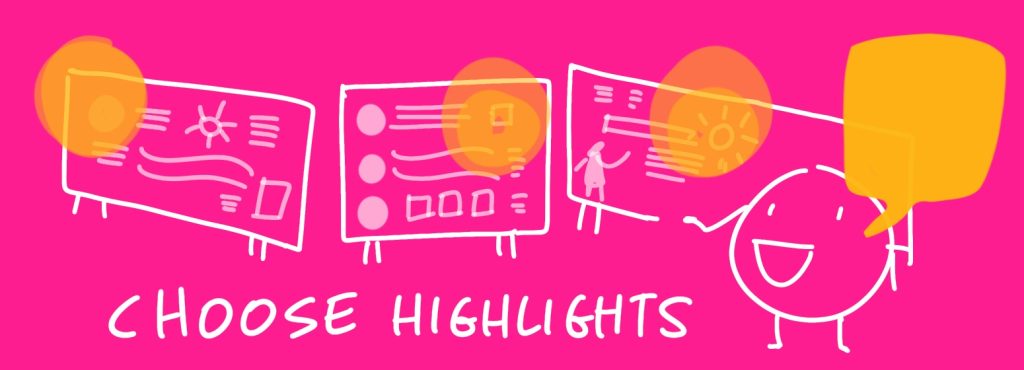 2. Reading a presentation word for word is boring. Instead, synthesize your own work, choose highlights, and stories.
2. Reading a presentation word for word is boring. Instead, synthesize your own work, choose highlights, and stories.
I get bored easily when a presenter is reading me exactly the same text that is on the slides. And if your graphic recording has a lot of detail, it will take too long.
Instead, try to synthesize your own work: combine different parts on the page to create a more complex understanding. “All of these sections here speak to increasing internal capacity.”
You can also choose highlights to mention, especially if your role was to graphic record during group work. “We had four questions for group work, and here is a highlight from each topic.”
And always remind people of the moral of the story, especially if there was a great keynote speaker. “We could never forget this presentation – and their unmistakable reminder to always ____!”
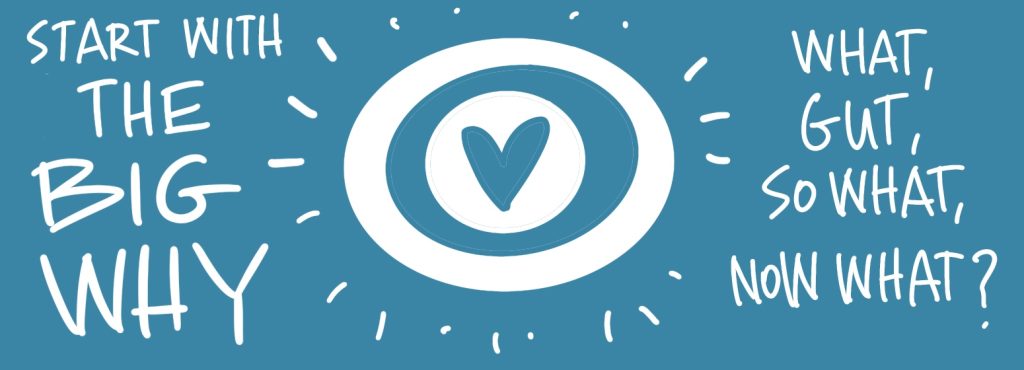 3. When you don’t know what to say, start with the Big Why, and then go What, Gut, So What, Now What.
3. When you don’t know what to say, start with the Big Why, and then go What, Gut, So What, Now What.
Memorize the Big Why that the client has told you the event is happening, and start with that. The title of the event might be “The Annual All-Staff Meeting”, but their Big Why is more interesting: “As we all know, this is the only time all year that all 150 employees are gathered in one place – and we’re here to talk about the vision for the company.” Don’t make it up. To do your work well, you have to go into the event knowing why this meeting matters.
Then, look at your graphic recording posters holistically with a framework of What, Gut, So What, and Now What. (This is also known an ORID framework but this is a catchy way to remember it). I recommend that you choose different amounts of time on the different steps, depending on the type of event/meeting you are supporting. If the meeting is highly technical or is mostly presentations, the “What” stage may be most important. If it is a strategic or decision-making meeting, you may want to maximize the last two steps.
What: Share back in an objective way first. Stick to the key facts, the topics covered, and look for clues in the session titles. Don’t interpret or editorialize anything yet. “We covered a lot of ground today with many presentations ranging from future pandemic preparedness to how we’re going to develop a roadmap for the next respiratory pathogen pandemic.”
Gut: With the perspective of the participants, reflect back how they felt about it. What surprised them? What challenged their thinking? “We heard that it’s easy to feel overwhelmed with the amount of work to do in a crisis! But remember Dr Sylvie, ‘we don’t exchange business cards in a crisis.” You may want to point to 1-2 places on the graphic recording posters where this came up.
So What: this is often the most interesting part for a graphic recorder to share back to the room when there is a dialogic process. What does it all mean? What are the key messages? What new things did we learn? “From the afternoon discussions, at least 3 main priority areas emerged. Now we know we need to talk about emergency coordination, community protection, and clinical care.” Spend the most time here with your share-back, because the information is new.
Now What: Highlight any decisions and next steps that the group identified. “With this input, we heard that you’ll be ready to launch this new program in 2 months.” And a wise reminder here- you’re not there to give any extra answers.
I like to script my conclusion. I end with two things: inviting people to engage with me about the graphics or how they will receive them; the final sentence is about why we invite visuals to support their best work. End strong!
 4. Learn how to explain what you drew. Talk about your process, your choices, and how you listen.
4. Learn how to explain what you drew. Talk about your process, your choices, and how you listen.
I get it, sometimes we don’t know where a drawing might come from. Or our best laid plans got sidetracked. But you are there to visualize for a group, so you need to be able to talk about some of your choices. Not many people get to hear from an artists’ perspective talking about their work, so don’t underestimate the power of making clear in words what they see on a page. Here’s some things I might share about.
- This page layout can be read right to left (or from the center out) because …
- These lines here are dotted / solid / extra thick/ to show different connections because ….
- I’m using these colours because they mean …
- I heard many key details in this section, and combined them in this drawing, such as ….
- This abstract shape/line/ swoop means ….
- The drawing of _____ represents ____ because ….
- This information is organized into a model because…. (eg it’s an iceberg because we were talking about the systems and beliefs that are under the surface ….)
- I’m listening differently to parts of the agenda here, because…. (eg the brainstorming is here in a long divergent list, and then our decisions about themes converge into these big circles here)
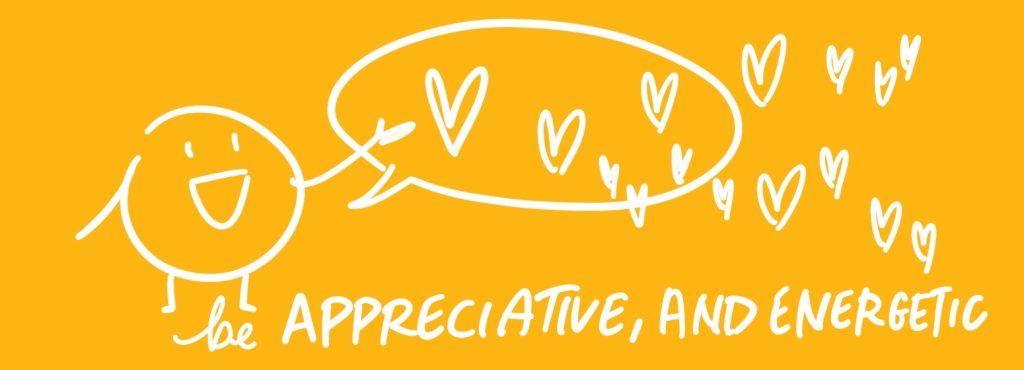
5. Don’t upstage anyone. Be proud of your work, be appreciative, and show up with energy.
Sometimes you’ll be the star, but you’re not there to be a diva. Be proud of your role and bring great energy to your share back, or fake-it-til-you-make-it energy with a clear voice. People are excited to see something new to them like graphic recording, and your tone and presentation should demonstrate that you support this group and their work. Be generous with your gratitude, including thanking the facilitators, client/sponsors, and all supporting roles.
Be appreciative, which includes making the participants look and feel good – because they are the experts on themselves. There might be some meetings where you think you have more expertise than the room, or you have an “answer” for a particular challenge. You don’t. This group has a different experience than you and sees things differently. You have to appreciate the meeting for what it is: you’re not there to solve anything “for” them in a share-back, by surprising them with new content or proposing a process. If you have a burning case of Correct-itis, write it down on a post it and offer it after the meeting.
Record them on video, with accessible captions
You can record your graphic recording share-back if you are online, which makes a descriptive and oral record of the moment for people who also may be visually impaired. You can also caption these videos. When posting online, you can write alt-text for graphic recording images – and also consider other ways of sharing back the work out loud.
In conclusion, consider the share-back another important skill of an established and confident graphic facilitator and try to practice and prepare for it, just like we prepare for the other parts of our roles. It’s technically public speaking – but we know you can already do hard things like drawing on a blank page in front of strangers!
